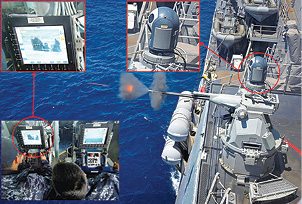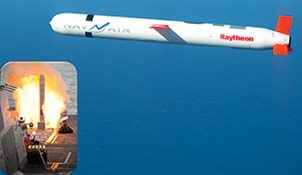

The EOS also has a stabilisation circuitry. This MGS is physically position-stabilised using motors, which are, in turn, directed by this stabilisation circuitry. This stabilisation circuitry uses semiconductor accelerometers, which provide an output whenever their physical orientation is changed (due to waves). The stabilisation circuitry accordingly directs the motor and keeps the cannon stabilised. When the ship heaves up, this stabilisation helps to keep the gun to face the point at which the crosshairs of the EOS point. The computer present in the EOS checks orientation of the crosshairs of the EOS.
There is a laser range finder present in the EOS that detects the distance of the target. The EOS computer automatically orients the gun, so that when fired, shells land at that point where the crosshairs are pointing. The EOS computer maintains the gun on the required orientation regardless of the ship’s heaving.
This system is expected to be capable of efficiently neutralising suicide boats even before these can approach the ships. It is being progressively fitted in the vessels of US Navy.
Strike warfare
Strike warfare, the only offensive operation and purpose of the CSG, is neutralising land targets deep inside enemy territory. Targets can be airbases, marching troops, rolling tank columns, bunkers, SAM sites, factories, power plants, dams and the like. For neutralising these, the CSG has two options; one is by launching combat aircraft and the other is by firing land-attack cruise missiles.
Tomahawk land attack missiles (TLAMs). When a requirement to strike a target arises, possibilities are assessed. If the target is a single target, say, a command bunker, situated deep inland, it will be well defended by enemy SAM systems all the way from the shoreline. A single-strike aircraft cannot be sent to engage the target situated deep inside enemy territory.
Enemy would also have combat aircraft nearby. The strike aircraft has to fight both the enemy combat aircraft and enemy SAM systems. So a group of four strike aircraft is launched. These aircraft may need refuelling aircraft and EW aircraft like E/A-18 growler’s support. Even then if the threat level for the strike aircraft is high, TLAMs will come into play. These are complementary to strike aircraft. These are high-precision land-attack cruise missiles capable of hitting one building among other buildings. TLAMs have a range of more than 1000km and are nuclear-capable.
Aegis destroyers and cruisers are armed with TLAMs. The CSG commander issues target details through a strike-warfare commander to the ship that has to launch the missiles, which are fed to the FCS of the TLAM. TLAM’s FCS, in turn, feeds trajectory and target details to the missile’s guidance system.
Theoretically, a CSG can launch as many as 300 TLAMs in minutes but these do not carry that many. TLAMs typically start the strike by taking out enemy air-defence C2 centres. This blunts the enemy’s air-defence architecture. Following these strikes, strike aircraft are launched to take out the targets assigned to these. This is how Operation Desert Storm was conducted against Iraq in the year 1990.
Air operations will be covered in the next part.










